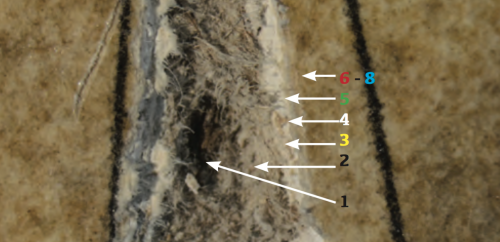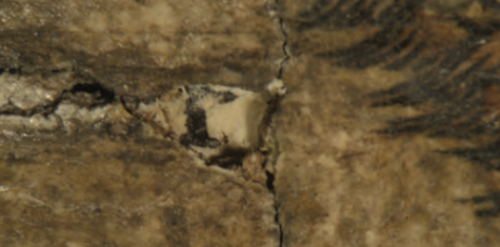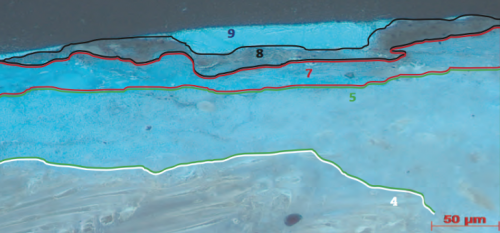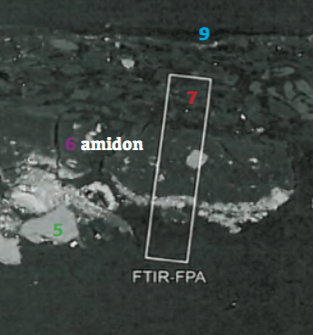Stratigraphic cross-section of the terrestrial globe. Lower left: area where the sample was taken in current-day Gabon, longitude 40. © SIK|ISEA
Here in detail is the composition of the terrestrial globe, from the inside towards the outside. Based on stratigraphic cross-sections and various analyses of samples taken from the spheres of both globes, it was possible to identify a large number of the constituent materials. However, only samples of the outer layers could be taken for these analyses (layers 4 to 9), which is why the descriptions of the inner layers are less precise.
Layers 0.-1.
The inner structure of the shells comprises a mixture of different layers made of wood fibres, pieces of cloth and paper/cardboard. The deepest visible layer is dark brown and made almost entirely of wood fibres/chips.

Area where the C14 sample was taken. In yellow, the varnished paper and then the various layers. © SIK|ISEA
Layer 2
Above this layer we find a layer made of grey cellulosic fibres, probably cardboard or papier mâché. Among these layers (0-2), whole pieces of printed paper were probably used. Binocular magnifier observations revealed a printing press character (an “r”) in the hole where the sample of the stratigraphic cross-section of the terrestrial globe was taken.

Details of the terrestrial globe, microscope photo: printing press character. © SIK|ISEA
Layer 3
Then comes a preparatory first white layer made of chalk and proteic glue.
Layer 4
On top of this lies a thick pinkish layer made from a mixture of materials: cellulosic fibres, chalk and proteic glue. The cellulosic fibres come either from wood sawdust or from cardboard or paper (or from a mixture of both).

Stratigraphic cross-section of the terrestrial globe under UV fluorescence. Layers 4 to 9 stand out clearly. © SIK|ISEA
Layer 5
Next, we find a new preparatory white layer made of chalk and proteic glue (probably skin glue). This stratum comprises at least two preparatory layers, probably sanded, very smooth and regular.
Layer 6
Layer 6 does not exist in all the stratigraphic cross-sections. It is made of starch and proteic inclusions. The material is the starch glue used to paste the paper gores to the chalk preparation.

Stratigraphic cross-section of the celestial globe viewed by a scanning electron microscope showing the starch layer. © SIK|ISEA
Layer 7
The paper layer (the printed gores) is dark because the samples were taken around an older gap where the paper is dirtier.
Layer 8
The ink and colours used to colour the proofs were also analysed. The ink (brown-black) contains vermillion, burnt umber, kaolinite, quartz and traces of arsenic. The colours are made from a proteic binder and oil. Analyses revealed the following pigments: hematite, litharge, brown iron oxide and copper green.
Layer 9
Finally, the sphere was varnished. The outer varnish is not the original one; remains of an older varnish can be found underneath (darker areas). Unfortunately, the two varnishes could not be analysed separately. These varnishes are made of natural dammar or mastic resin with traces of fat (oil?).



